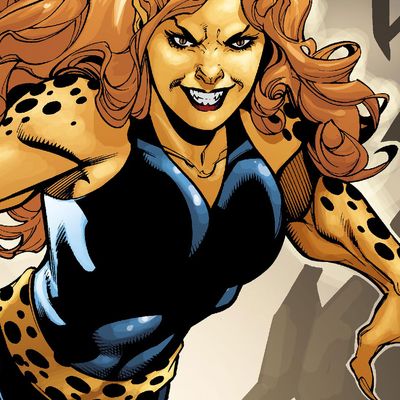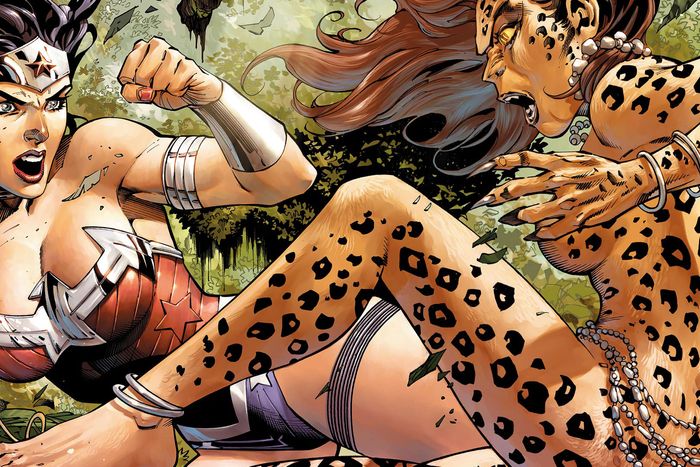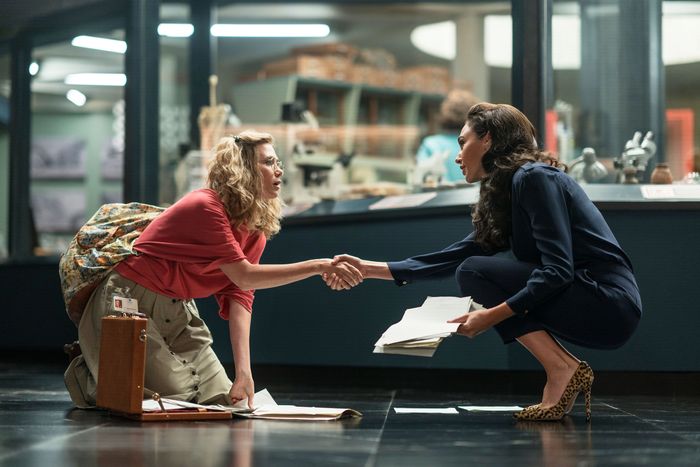
When Barbara Minerva first appears on panel in 1986’s Wonder Woman #6, she’s a far cry from the shy interpretation put forth by actor Kristen Wiig in this year’s DC cinematic release. She’s a haughty character, a British aristocrat with an ancestral home in Nottingham, seen sprawled on a canopy bed in her castle awaiting a manservant with her the daily dose of news. Only six issues in, the second volume of the Wonder Woman comic already had a wealth of supporting female characters, but Barbara was different. She was all sharp edges and classic villainous hallmarks; a long nose and a cutting jaw, angry eyes and clutching fingers. In her second appearance, the very next issue, she’s flying to the United States, an absolute nightmare of a passenger, chewing out an in-flight stewardess over the preparation of her steak. In short, she is the kind of character readers love to hate.
Despite an entertaining debut, however, Barbara’s transformation into the ultra baddie Cheetah has not exactly rendered her iconic. Casual comic fans are certainly aware of Barbara Minerva, but in an absolute sea of female and feline-themed super villains, Cheetah hasn’t exactly shined. “She was always less interesting as a foil to Wonder Woman, because she often got overshadowed by fights with actual deities and mythological figures,” critic and DC Beat reporter Cori McCreery points out. In fact, there have been a total of four Cheetah incarnations dating back to 1943, each one representing a different kind of archenemy. (Contrast that with the far more popular DC baddie Catwoman, who has always been Selina Kyle.) Still, of the four people (including one man) who have worn the mantle, the most memorable is Barbara Ann Minverva, who’s largely maintained a monopoly on the villainous identity since 1986, and who has the fortune of appearing in this year’s Wonder Woman 1984.
Barbara’s creator is writer and artist George Pérez (assisted by the late writer and editor Len Wein). It’s hard to overstate Pérez’s importance to the legacy of Wonder Woman. In ‘86, DC had just finished publishing the major streamlining event that was Crisis on Infinite Earths, a year-long project with the specific aim of cleaning up 50 years of muddled continuity. Today, we understand the shared universes in which superheroes operate; Superman and Batman are old friends, Daredevil and She-Hulk have faced each other in the courtroom as their lawyer alter-egos. But there was no trace of this shared world when Wonder Woman first graced the pages of All-Star Comics #8 and heroes interacted in episodic, often contradictory adventures. This came to a head in 1981, when a sharp-eyed fan wrote a letter to Marv Wolfman, the then-writer for Green Lantern, to point out that a DC character had failed to recognize another, despite the fact that they’d met a few years prior in another comic. By 1985, complaints like this had coalesced into a line-wide event that divided DC Comics’ fictional history into two eras: Pre-Crisis, the first fifty years of publications, and Post-Crisis, everything that would come after.
Pérez, a rising star and recently contracted exclusive artist for DC, not to mention the regular artist at the time on New Teen Titans (which Wolfman also wrote), was tapped to do the art for Crisis. It was a smash hit, and the resulting single, shared universe offered freshly updated origin stories for the publisher’s entire stable of characters, and a clear message that these were the official biographies going forward. For Wonder Woman, this meant a new mythology. But in a retrospective interview with 13th Dimension, Pérez explained that writers weren’t exactly lining up to rewrite her history: “I didn’t realize at the time that ever since the death of (creator) William Marston and H.G. Peter, the original artist on Wonder Woman, there hadn’t been a single writer or artist who ever volunteered to do that book. It was an assigned book. No one wanted to do Wonder Woman. I was the first person [to volunteer] — particularly at a time when I could have asked for any possible project and they would have said yes to it.”
Pérez leaned heavily on Wonder Woman’s Greek origins, taking inspiration from Walt Simonson’s recent revamp of Thor over at Marvel. He reintroduced not just Wonder Woman and the Amazons, but also the Greek Gods and mythological figures like Heracles. In terms of villains, Pérez built Ares, the God of War, into a perfect nemesis, hellbent on manipulating world powers into a nuclear war. It was a storyline so successful that it would eventually come to be adapted into the plot of the first Wonder Woman film in 2017.
Pérez also turned to classic villains like The Cheetah, formally the alter ego of Priscilla Rich, a wealthy debutante envious of Wonder Woman and who made multiple attempts at murdering the hero or framing her for various crimes. The costume was eventually taken up by Deborah Domaine, Rich’s niece, in 1981, who would only appear a handful of times before the events of Crisis on Infinite Earths. But in Post-Crisis DC, Pérez and co-scripter Wein left Deborah behind and established Barbara Minerva, an archeologist with a critical lack of compassion and a selfish streak a mile wide. Barbara was a character with potential; here she was, an unscrupulous looter of ancient artifacts, a diametric opposite to Wonder Woman, who hailed from an ancient civilization.
But Pérez and Wein opted to give Minerva actual superpowers, something that her predecessors lacked, and here, her story takes a less than appealing turn. On an expedition into Africa, she discovers a hidden tribe of indigenous people who worship a cat god — the Cheetah — with an earthly incarnation granted powers by the consumption of a mystical plant. (Sound familiar?) After a chaotic chain of events amounts to the entire tribe’s murder, save for one old shaman named Chuma, he conveniently sees in Barbara the potential for a new Cheetah avatar. And so Chuma travels back to the UK with Barbara and proceeds to serve dual functions; he simultaneously facilitates her Cheetah powers while also playing the part of a manservant. He lives in her residence, receives guests, is obsequious, the works. Barbara experiences some consequences for her actions; cat god Urzkartaga requires his avatars be virginal, and since Barbara is not, she is racked with weakness and pain when not in her Cheetah form and overcome by bloodlust when she is. But her colonialist drives are rarely interrogated with real thought. In an interview published in the January 1989 issue of the now-defunct comics magazine Amazing Heroes, Pérez sidestepped discussing the stereotypes he’d baked into Barbara’s origins: “That’s the thing about these jungle-type stories. Who’s there to research them?”
Pérez left the book in 1992 with issue #62, and Cheetah as a character became directionless, only occasionally popping up to attempt to steal Wonder Woman’s lasso, another ancient artifact she coveted. As his final act at the helm of Wonder Woman, Pérez gave his villain a potion that would permanently transform her into Cheetah, the trade-off being that she’d be enthralled to another Wonder Woman villain, the witch Circe. Then, under the hand of incoming writer William Messner-Loebs, Barabra would spend 30 issues trapped in an alternate dimension before reappearing in Wonder Woman #94-100 in the service of other villains once more, when a mob boss by the name of Julianna Sazia found a way to bring her back from her extra-dimensional prison and use her as a weapon. Not particularly pleased with this, Barbara betrayed Julianna, joining forces with Wonder Woman to defeat her.
In the latter half of the ‘90s, famed comic creator John Byrne sought a return to the character’s roots — so much so that he resurrected Barbara’s reliance on a shaman. Barbara didn’t show up again until the mid 2000s, in an arc with Argentinian business tycoon Sebastien Ballesteros, who briefly stole Barbara’s powers and identity. This proved to be perhaps Barbara’s only continuous theme up until this point: loss of agency, loss of power, lack of control in her own life.
That is, until writer Gail Simone took the helm in 2007. Simone was the longest-running woman to write Wonder Woman, who opted to put Barbara Minerva back in the driver’s seat of her own story, featuring her in human form heading up a team of scientists and enacting a plan to defeat Diana in a run called Rise of the Olympian. This was the first time Cheetah would pose an intellectual threat to her foe. When Barbara did finally appear in her Cheetah form, it was in classic villain fashion — to enjoy a victory, to gloat, and it would of course prove her undoing.
Cheetah would go on to feature in series like The New 52 and DC Rebirth with new origin stories, further complicating the often revised character of Barbara Minerva. It might be this constantly shifting aspect of her presentation that made her such a prime candidate for a 2020 film adaptation. Wiig’s Barbara first appears in Wonder Woman 1984 in baggy clothes with unkempt hair and large glasses, nothing like the sharp, angular British aristocrat of DC past. Director and co-writer Patty Jenkins seems intent on avoiding the troubling tropes tied to Pérez’s Cheetah’s origins, rewriting her arc to include a magic-endowed ancient rock that grants her a wish to become powerful like her friend Diana, and later, like a certain apex predator. Maybe it’s a missed opportunity for DC to interact with its historic pitfalls, or to challenge Wonder Woman’s relationship as a steward of ancient civilizations, but in the vein of Simone’s writing, the new Barbara isn’t beholden to anything but her own unquenchable desires. It might not make her a baddie cinephiles love to hate, much less render her iconic, but it’s a clearer direction for a character long hampered by the whims of an ever-evolving comic universe.







